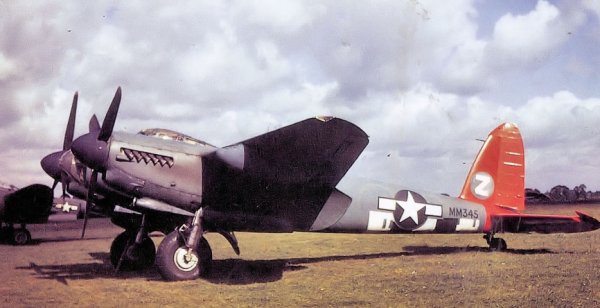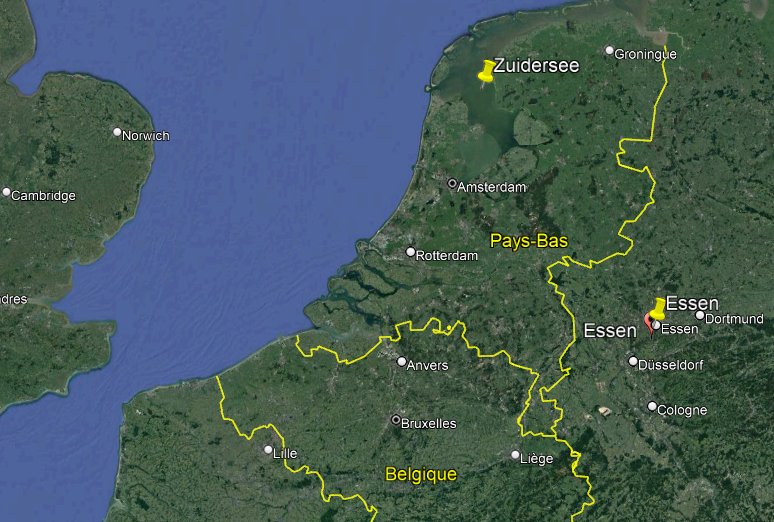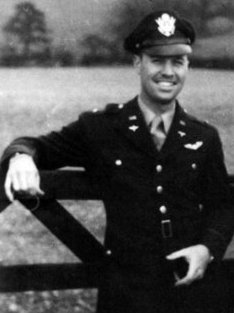ACUFO-1945-01-01-ZUIDERZEE-1
Several ufology sources of the 2000's published about a sighting on January 1, 1945, over the Zuiderzee, in Holland.
It is said that during that night, Lieutenant Jack Green, pilot, and Lieutenant Warren Barber, navigator, from the 653rd Squadron of the 25th Reconnaissance Bomb Group, 8th Air Force of the U.S. Army Air Forces, were conducting a meteorological mission over Belgium, Holland and north central Germany. For four and a half hours, they flew their Mosquito under radio silence orders.
Flying at 30,000 feet over Zuiderzee on their way to Berlin, at 02:30 a.m., they saw strange lights. According to Lieutenant Green, the night was “beautiful and starry.” It was also very cold and at that altitude, temperatures reached 50 to 60 degrees below zero.
The strange lights appeared of were seen suddenly, dead ahead, at the same altitude. They were described as two balls of orange fire, and the pilot first thought that they were jet planes.
The crew noticed that they were moving in their direction in straight line “at a rate of closure that was not unusual”.
As they moved, they seemed to be in tandem, as if somehow connected, retaining the same apparent distance from each other.
Then they moved so as to pass off their starboard wing at the same altitude. At a point about 120 degrees from their nose, they shot upwards at a rate of climb that could only be described as incredible. At a point about 70 degrees up from the horizon, the ball of fires went out.
They continued their flight, and two other pairs of these lights appeared suddenly off their port wing, flying level formation with them. They appeared quite close and slightly larger than those they saw first. They shot up to 60 or 70,000 feet, higher than the aircraft, in front of it, and them zoomed towards the back.
According to Lieutenant Barber, “they were three-foot circular light, like a ball and they did not appear to be solid. The lights could change speed rapidly, climbing and diving, and it seemed to me that they were being used to position us.” The lights remained 20 minutes before they disappeared.
When they arrived back at the base, Lieutenant Green said the next day their report was given to their squadron's Air Intelligence officer who told them to keep it secret.
The indicated sources were the 1996 war History book “Air Intelligence of the Eighth Air Force”, by George Sessler, and the 2007 book “Strange Company - Military Encounters with UFOs in World War II” by Keith Chester, in which the report was based on personal correspondence of Keith Chester with Warren Barber in 2003.
Another source said the plane was a British Mosquito reconnaissance aircraft was flying over the Zuiderzee area of Holland, flying an unescorted weather intelligence mission, crewed by a pilot and navigator; this source says that the mission report by the base intelligence officer told:
Crew observed pairs of bright yellowish orange lights evenly spaced which seemed to be floating around in the air, never in front, but always in rear or on either side. Lights were brilliant while on and at times faded, either in the distance, or were turned off. Aircraft was at 30,000 feet when lights were first seen. While over Zuder Zee at 02:30 hours lights were seen for first time and as aircraft approached Berlin at 03:10 hours two more were observed. Getting closer to Berlin, at 0330 hours, three were seen. No attacks were made on aircraft hence the crew was not certain as to identity of lights.
| Date: | January 1, 1945 |
|---|---|
| Time: | 02:30 a.m. |
| Duration: | 20 minutes. |
| First known report date: | 1945 |
| Reporting delay: | Hours, days. |
| Country: | Holland |
|---|---|
| State/Department: | Zuiderzee |
| City or place: |
| Number of alleged witnesses: | 2 |
|---|---|
| Number of known witnesses: | 2 |
| Number of named witnesses: | 2 |
| Reporting channel: | Military operations report, personal testimonies. |
|---|---|
| Visibility conditions: | Night. |
| UFO observed: | Yes. |
| UFO arrival observed: | Yes. |
| UFO departure observed: | Yes. |
| UFO action: | Approach, maneuvers. |
| Witnesses action: | |
| Photographs: | No. |
| Sketch(s) by witness(es): | No. |
| Sketch(es) approved by witness(es): | No. |
| Witness(es) feelings: | ? |
| Witnesses interpretation: | Enemy localisation devices. |
| Sensors: |
[X] Visual: 2.
[ ] Airborne radar: [ ] Directional ground radar: [ ] Height finder ground radar: [ ] Photo: [ ] Film/video: [ ] EM Effects: [ ] Failures: [ ] Damages: |
|---|---|
| Hynek: | NL |
| Armed / unarmed: | Armed, 4 7.62 mm Browning machine guns and 4 20 mm Hispano cannons. |
| Reliability 1-3: | 2 |
| Strangeness 1-3: | 2 |
| ACUFO: | Possible extraterrestrial craft. |
[Ref. dwn2:] DOMINIQUE WEINSTEIN:
During the night, pilot Lt Jack Green and navigator Lt Warren Barber from the 653rd Squadron (25th Reconnaissance Bomb Group) were conducting a meteorological mission over Belgium, Holland and north central Germany. For four and a half hours, they flew their Mosquito under radio silence orders. They were flying at 30,000 feet over Zuder Zee on their approach to Berlin. It was 2h30 when the strange lights first appeared. According to Lt Green, the night was “beautiful and starry.” It was also very cold and at that altitude, temperatures reached 50 to 60 degrees below zero. The battle of Bulge was raging below them. “Suddenly, dead ahead, at the same altitude, were two balJs of fire orange. The pilot first thought that it was jets. But then it became apparent that they were moving in their direction at a rate of closure that was not unusual. As they moved, they seemed to be in tandem, as if somehow connected, retaining the same apparent distance from each other. They came in straight line towards them, then they moved so as to pass off their starboard wing at the same altitude. At a point about 120 degrees from their nose, they shot upwards at a rate of climb that could only be describe as incredible. At a point about 70 degrees up from the horizon, the ball of fires went out.
As they continued their flight, two other pairs of these lights appeared suddenly off their port wing, flying level formation with them. They appeared quite close and slightly larger than those they saw first. They shot up to 60 or 70,000 feet, higher than the aircraft, in front of it, and then zoomed towards the back. According to Lt Barber, “they were three-foot circular light, like a ball and they did not appear to be solid. The lights could change speed rapidly, climbing and diving, and it seemed to me that they were being used to position us.” The lights remained 20 minutes before they disappeared.
When they arrived back at the base, Lt Green said the next day their report was given to their squadron's Air Intelligence officer who told them to keep it secret. Duration: 20 minutes
Sources: Air Intelligence of the Eight Air Force, George Sesler [sic], 1996 / Strange Company, Keith Chester, 2007 (Personal correspondence of Keith Chester with Warren Barber in 2003).
[Ref. sua1:] "SATURDAY NIGHT UFORIA" WEBSITE:
ON THE SELFSAME DAY that war correspondent Robert C. Wilson filed his dispatch on 'foo fighters' and the 415th -- January 1, 1945 -- a British Mosquito reconnaissance aircraft was flying over the Zuiderzee area of Holland some 300 miles northwest of the 415th's base near Nancy, France. Though not on a combat mission, the danger was extraordinarily high -- a lone aircraft, unescorted, crewed by a pilot and navigator, their mission to gauge meteorological conditions over Germany, and in this case the most heavily defended part of Germany -- Berlin. From the after-mission report by the base intelligence officer...
Crew observed pairs of bright yellowish orange lights evenly spaced which seemed to be floating around in the air, never in front, but always in rear or on either side. Lights were brilliant while on and at times faded, either in the distance, or were turned off. Aircraft was at 30,000 feet when lights were first seen. While over Zuder Zee at 02:30 hours lights were seen for first time and as aircraft approached Berlin at 03:10 hours two more were observed. Getting closer to Berlin, at 0330 hours, three were seen. No attacks were made on aircraft hence the crew was not certain as to identity of lights.
[... other cases...]
2. The January 1, 1945 report of lights over the Zuider Zee is recounted by witnesses in vivid and exciting detail in Keith Chester's book Strange Company, which gives as its source Aerial Intelligence of the 8th Air Force by George Sesler. The Sesler book appears to be a limited run and further research revealed accusations of plagiarism, and for those reasons the purported personal accounts of the pilot and navigator, though thrilling, are regretfully not included here even in summary. Chester's book, however, does also include further vivid detail obtained through personal interviews and correspondence. These accounts also illustrate the wide gulf between the official reports given in dry terms, and the vivid accounts told by pilots to interviewers.
[Ref. tai1:] "THINK ABOUT IT" WEBSITE:
Date: Jan. 1, 1945
Location: Ardennes, Belgium
Time:
Summary: Pair of fog lights; bright yellowish orange; flying in tandem; three feet in diameter.
Source:
[Ref. get1:] GEORGE M. EBERHART:
January 2 - 2:30 a.m. USAAF Lieut. Jack Green and navigator Lieut. Warren Barber, 653rd Bombardment Squadron, are conducting a reconnaissance flight in a Mosquito over the Netherlands and northern Germany when they encounter two balls of fire on three occasions pacing their plane. Barber describes them as a “pair of fog lights, shooting up to 60 or 70,000 feet.” (Strange Company 114-116, 208-209)
The de Havilland DH.98 “Mosquito” was a British multirole aircraft, which served as a fighter-bomber, torpedo bomber and reconnaissance aircraft with the Royal Air Force during the Second World War.
Its armament was 4 7.62 mm Browning machine guns and 4 20 mm Hispano cannons.
Its pilot and its navigator were seated side by side, the navigator being shifted back about thirty centimeters for shoulder width.
Below: a Mosquito of the 653rd Bombardment Squadron of the U.S. Army Air Forces.

|

|
The 25th Bomb Group (Reconnaissance, Special) was one of the Eighth Air Force most important and most unique units. Operating a variety of aircraft, the unit provided weather data vital to 8th AF strikes, scouted targets for strikes, dropped OSS agents into occupied Europe, flew photo reconnaissance missions and other duties as required.
The 25th Bomb Group was made up of the 652nd Bomb Squadron (Heavy, Recon.), the 653rd Bomb Squadron (Light, Recon.) and the 654th Bomb Squadron (Heavy, Special). The 652nd flew B-17Gs and B-24D/Hs on meteorological flights over the Atlantic to provide 8th AF planners with developing weather info. The 654th and 653rd also used Mosquitos for weather observation and forecasting flights, chaff dropping, target scouting, etc.
The primary source was actually “25th Bomb Group, Reconnaissance Special, 1944-1945, Watton, England”, a 1996 book by George R. Sessler.
I identified pilot “Jack Green” as John William Green IV, aka John “Jack” William Green (photo below). He was born in Manila, Philippines, on October 16, 1920, his father was Colonel John W. Green, III, U.S. Army veteran serving as Chief of Police. Green attended Central High School in Washington, D.C. and won honors as the Cadet Colonel Commandant. He attended college at Deep Springs, California, and at the time of his enlistment, he was a pre-medical student at Stanford University. Jack Green enlisted in February 1942, attended Officer Candidate School at Fort Benning, Georgia, and then trained as a pilot. He completed 30 combat missions as a B-17 pilot and later as the Squadron Commander of the 25th Bomb Group, flying over 47 night combat missions in the light weight British Mosquito in Europe during WWII. His decorations include the Distinguished Flying Cross, the Air Medal with 7 Oak Leaf Clusters, and the Croix de Guerre from General Charles de Gaulle for the liberation of France from June-December 1944.

|
The most widely read account of Jack Green's combat experience appeared in a United Kingdom best-seller, “Serenade to the Big Bird,” by Bert Stiles and later in “Serenade to the Blue Lady” by Robert Floyd Cooper.
After the war he was a test pilot and a pilot instructor, and later the author of a number of military articles. His most recent writings appeared in “Aerial Intelligence of the 8th Air Force,” an accounting of the 25th Bomb Group (RCN, SP), headquartered in Watton, England from 1944-1945. He was a member of the Mosquito Aircrew Association of England. He died at 77 in 1998.
I identified the navigator as Warren R. Barber, indeed member of the 653rd Bomb Squadron.
Barber thought that the lights they had seen “were being used to position us.” This is an interpretation given by the pilots in several reports, and even the Press of the time. The idea was that these “balls of fire” were a new German weapon, radio controlled from the ground, which would give to the flak where the enemy plane was.
This was a rational idea at the time in this context; but many airmen pointed out that this made no sense: such devices never resulted in flak fire.
This is why some newspapermen then suggested that they were some sort of “psychological weapon”; but again, the airmen were not scare to the point that this would have had any efficiency.
After 1947, many airmen heard about the first so-called “flying saucers” and realized that this was, or may have been, what they encountered in WWII.
We have in this report most of the constants of what I would call the “good reports” of Foo-Fighters. The major point is that although the “balls of fire” follow the plane, with one sequence of at least 20 minutes, they do not fire. Certainly we can sometimes imagine a German fighter plane that ran out of ammunition, but here, there would have been several times fighter planes without of ammunition, above German territory moreover, while the German fighter in such interceptions actions would certainly not use precious fuel in vain interceptions without ammunition.
At this period, for example, there were Messerschmitt Me-262 jet planes in their two-seater night fighters version, with on-board radar, based near Berlin, for which they were supposed to ensure night defense. It is quite unimaginable that they approached the Mosquito without shooting at it.
Possible extraterrestrial craft.
* = Source is available to me.
? = Source I am told about but could not get so far. Help needed.
| Main author: | Patrick Gross |
|---|---|
| Contributors: | None |
| Reviewers: | None |
| Editor: | Patrick Gross |
| Version: | Create/changed by: | Date: | Description: |
|---|---|---|---|
| 0.1 | Patrick Gross | December 23, 2023 | Creation, [dwn2], [sua1], [get1], [tai1]. |
| 1.0 | Patrick Gross | December 23, 2023 | First published. |